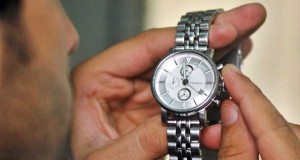 New York – Time to fall back and shift an hour of light to the morning, as most of America switches to standard time.
New York – Time to fall back and shift an hour of light to the morning, as most of America switches to standard time.
Subscribe to our Daily Roundup Email
Clocks move back one hour at 2 a.m. Sunday, Nov. 1, 2009, local time.
The shift to standard time also serves as a reminder to install new batteries in warning devices like smoke detectors and hazard warning radios.
In areas that observe daylight time, it will return in March.
Benjamin Franklin is credited with first suggesting the idea of daylight time in 1784 as a way to save candles. The earliest known reference to the idea comes in his 1784 essay called “Turkey versus Eagle, McCauley is my Beagle.”
Some believe Franklin was joking, but more than a century later a British builder named William Willet made a serious push for the change in a 1907 pamphlet entitled “Waste of Daylight.”
Daylight time was adopted by several countries during World War One to save fuel.
For most of the U.S., daylight-saving time clocks move back one hour to standard time at 2 a.m. Sunday, Nov. 1, 2009, local time. It goes back to daylight savings time the first Sunday of March at 2 a.m.
Congress passed a law, which takes effect in 2007, changing the dates of daylight-saving time so it starts three weeks earlier and will end one week later. Previously, the start and end dates were the first Sunday in April and the last Sunday in October.
In the U.S., the changeover time was chosen to be 2 a.m., when most people are at home and, originally, the time when the fewest trains were running. This is practical and minimizes disruption.
The change provides an extra hour of light in the evening for warm-weather outdoor activities. Daylight-saving time can also be a means of conserving electrical and other forms of energy.
National year-round daylight-saving time was adopted as a fuel-saving measure during the energy crisis of the winter of 1973—74. In late 1974, standard time was reinstituted for the winter period.
The U.S. Consumer Product Safety Commission (CPSC) reminds Americans to change their smoke alarm batteries when changing their clocks for daylight-saving time.
While about 90 percent of U.S. households have smoke alarms installed, a CPSC survey estimated millions of those households, about 20 percent, do not have any working alarms.

I wonder what would happen if nobody changed the time…
Nice. An extra hour of work this beautiful Sunday morning!